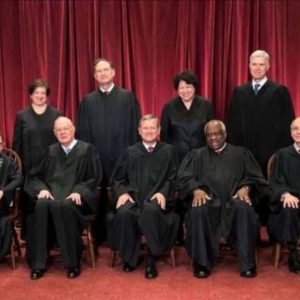Editor’s Note: For another viewpoint, see Point: Term Limits Would Make the Court More Recognizable to Our Founders
President Trump’s nomination of Judge Amy Coney Barrett to replace Justice Ruth Bader Ginsburg on the U.S. Supreme Court has ignited an expected, yet unfortunate, conflagration on the Left.
With few procedural levers to pull and little chance of blocking Barrett’s confirmation, the radical left wing of the Democratic Party has threatened to “pack the court,” if given the chance, by increasing the number of sitting justices.
Most Americans, regardless of political party, recoil at that idea, which is why Joe Biden and Kamala Harris refuse to answer direct questions on the subject. Now their handmaids in the media and on Capitol Hill have recently trotted out another misguided proposal that they hope will be more popular — term limits for Supreme Court justices.
Advocates for judicial term limits argue that such limits will reduce the rancor and bitterness of Supreme Court appointments. But the opposite is more likely.
The Washington Post opinion editors declared, “Judicial term limits are the best way to avoid all-out war over the Supreme Court,” by “lower(ing) the stakes of any one Supreme Court pick, so the (political) parties are not tempted to resort to all-out war every time a justice retires or dies. The best way to do that is to impose term limits — of, say, 18 years.”
Opinion editors at the Boston Globe agreed, arguing that “democracy would be better served by a High Court that is reinvigorated and renewed more frequently.”
Dozens of skirmishes and minor battles scheduled regularly will save democracy?
In fact, judicial term limits will likely heighten concerns of an over-politicized, all-powerful court. And a “reinvigorated” court is not what the country wants or needs.
Both sides of the political aisle already complain that the Supreme Court too often acts like a super-legislature that often overturns policy choices best left to the people and their elected representatives. As Justice Antonin Scalia once lamented, the court already behaves like an “ad hoc nullification machine,” striking down laws as if on political whim.
Alexander Hamilton explained that by making the tenure of federal judges permanent and not temporary, the Constitution ensures that the court’s make-up will not be changed according to the political interests or whims of another branch of government. This was an essential part of the delicate balance of power divided among the three federal branches, and designed to keep the court from becoming a political branch itself.
Removing that essential part risks making the judiciary more dependent upon the political branches, encouraging even more political meddling by those branches, and ultimately risking that the court will decide cases politically — that is, with one eye on the merits and the other eye on who may be leaving and joining the court in the next term.
Judicial term limits will make the High Court more powerful and more political, not less. They will increase the likelihood that justices may rule according to their own personal or political ambitions, rather than as dispassionate jurists with no proverbial dog in the fight. Ambition seeks more power. Dispassion typically does not.
Hamilton recognized that permanent tenure acknowledges the complexity of the law in a free society. Few people, he rightly believed, will have the knowledge and integrity necessary to judge the law, so those deemed up to the intellectual and moral task should be retained rather than episodically replaced.
Term limits undermine this effort. As Hamilton explained, justices preparing for their post-judicial positions may find it hard to resist the temptation to use today’s seat on the bench for tomorrow’s personal advantage.
A regular confirmation cycle will likely lead to more individuals “campaigning” for openings or alternatively encourage existing members to use their vote to make themselves more attractive for a post-court world — neither outcome suitable for a real federal court.
Although the bare-knuckle brawls that we call Supreme Court confirmations have become at best tiresome political theater and at worst unfair trials by a kangaroo court, the fights arise relatively rarely and last only a few weeks.
Making such appointments regularly and on a predetermined, biannual schedule will only call more attention to the court more often, not less, and will make the inevitable political fisticuffs virtually never-ending, as one side or the other will always be preparing for a preordained confirmation fight.
Term limits for the Supreme Court ultimately threaten the independence of the judiciary, risk a more powerful, more political, more ambitious court than we already have, and will likely make the problems that they seek to solve even worse.

